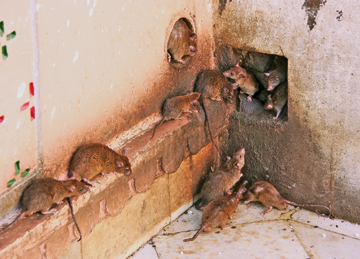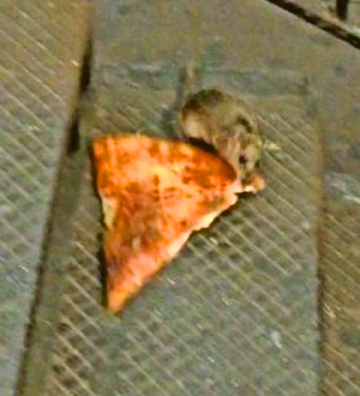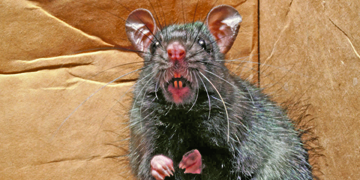City Of Glendale Takes Extraordinary Measures
by Mark Smiley
While 2016 is the Year of the Rat in the Chinese calendar, the City of Glendale is trying to ensure that 2016 becomes the Year of No Rats in Glendale. Construction up and down Leetsdale Drive the last few years has disturbed rat nests — in both Denver and Glendale. An infestation of rats has dominated portions along Leetsdale Drive including North Glendale and  surrounding Denver neighborhoods. These demolitions, tear downs and new developments cause the rats to look for new havens. Rodents run to the nearby buildings, producing a deep howl of rage from the residents.
surrounding Denver neighborhoods. These demolitions, tear downs and new developments cause the rats to look for new havens. Rodents run to the nearby buildings, producing a deep howl of rage from the residents.
In a small city like Glendale a problem doesn’t take long to move up the food chain to the mayor of the city, Mike Dunafon. “Residents from complexes in North Glendale would approach me and call me informing me of the rat problem,” said Dunafon. “I realized we needed to take immediate action along with the Glendale Police Department. I even got calls from various complexes that are in Denver, but I had to refer those over to the appropriate persons in Denver.”
The reason the problem cannot be ignored or overlooked is because rats are dangerous. Besides being simply unpleasant, they are frequent carriers of many diseases. Dr. Matt Perzanowski, a professor at Columbia University’s Mailman School of Public Health, whose research is focused on understanding the exposures that lead to allergy and asthma, said that rats and mice have special protein that could be a culprit in allergic reactions and, though it is less studied, probably to asthma as well.
Rats like to live where people live. They quickly adjust to the neighborhood. Rats can thrive on just an ounce of food and water daily, so when they enter a neighborhood and gain access to meat, fish, vegetables and grains, they will stay. Rats prefer to feed in and around homes, restaurants and businesses. But they will settle for scraps from trash bags and cans, private yards and what they find at the community refuse disposal and transfer station. Rats get the shelter they need from tall weeds and grass, fences and walls, rubbish piles and abandoned appliances.
Rats move freely in and out of buildings in the neighborhood, so any steps that neighbors take to control rats will encourage them to move into a nearby building. A community effort works best, where everyone in the neighborhood takes steps at the same time to prevent rats from entering the buildings and to remove their food and shelter.
Managing rats comes down to three things: food, water and shelter. Eliminating these three goes a long way to solving  a rat problem. The City of Glendale’s goal is to make the necessary changes to remove food and eliminate harborage that is attracting rats to sites around Glendale and surrounding Denver neighborhoods.
a rat problem. The City of Glendale’s goal is to make the necessary changes to remove food and eliminate harborage that is attracting rats to sites around Glendale and surrounding Denver neighborhoods.
Currently, the City of Glendale has contracted with Checkmate Pest Control and its owner Russell Carter. “The rats are most likely coming from Cherry Creek and they are able to move freely up and down the creek,” said Carter. “They are very good climbers, jumpers, runners, and hiders. They multiply faster than rabbits so you have to be proactive like Glendale.”
Mayor Dunafon has worked with city officials including Josh Bertrand, Director of Public Works, to help North Glendale residents feel safe again. Their efforts over the last couple of months have paid off. Glendale Public Works and Checkmate Pest Control regularly monitor city parks and sites with trash p
roblems, potential nesting areas, and adjacent problem areas in order to prevent the rat population from becoming out of control.
“We have seen a significant decrease in the amount of rats,” said Dunafon. “We are removing them and residents are once again feeling like there is progress. I am proud of how Josh [Bertrand] has helped manage this problem.”
“The mayor and Officer [Korbie] Perkins were helpful in limiting the rat situation in the best matters that were within guidelines of the city,” said Ali Langworthy, Assistant Manager of Urban Phenix. “They are still working with us diligently to continue to help us to eliminate these little creatures as quickly and efficiently as possible.”
Cities such as New York hav e been dealing with rats for hundreds of years. Fast forwarding to 2014, YouTube videos of rats on subway tracks and in a subway car in New York City went viral, as did videos of rats in a Dunkin’ Donuts in Manhattan. In June 2014, residents at adjacent Upper West Side buildings demanded an end to the rat problem they said had reached epidemic proportions, and started a rent strike.
e been dealing with rats for hundreds of years. Fast forwarding to 2014, YouTube videos of rats on subway tracks and in a subway car in New York City went viral, as did videos of rats in a Dunkin’ Donuts in Manhattan. In June 2014, residents at adjacent Upper West Side buildings demanded an end to the rat problem they said had reached epidemic proportions, and started a rent strike.
In 2015, another YouTube video of a rat carrying a slice of pizza in the subway went viral. Within 15 hours of the YouTube upload, the video was trending worldwide on Twitter and Facebook, and within two days, the video garnered five million views.
The City of Glendale is actively taking steps to make sure they do not end up the subject of a youtube video. The key to success is to preserve public safety and kill the disease carrying rats. Rodenticides are being used in this case and have been properly applied into the burrow systems so they cannot be reached by children and animals. The battle continues along Cherry Creek but the City of Glendale is taking strides to hopefully eliminate the problem completely.

